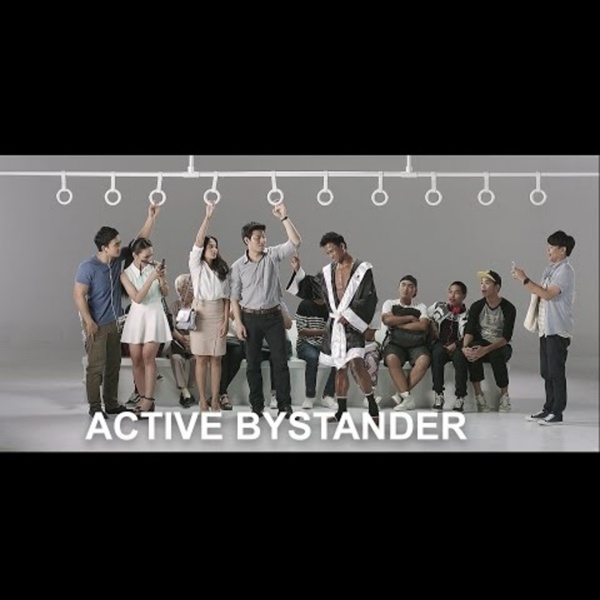



http://www.youtube.com/watch?v=yT9xtrLLPFc
Related: Bystander Effect 101 • Introduction to Psychology 2 - Bystander Effect • The Bystander Effect • The Bystander Effect • Bystander EffectDiffusion of Responsibility - Ethics Unwrapped Diffusion of responsibility occurs when people who need to make a decision wait for someone else to act instead. The more people involved, the more likely it is that each person will do nothing, believing someone else from the group will probably respond. Psychologists John Darley and Bibb Latané set up an experiment where a distress call made it appear that a person nearby had suffered an injury. When subjects heard the cry, and thought they were the only ones who heard it, 85% of them helped. But if subjects thought there was another person who heard the call too, only 62% helped. How to Break the Bystander Effect They could have left it to someone else. An Army veteran blocked a shooter in Oregon from entering his classroom. Three friends on a high-speed train from Paris to Amsterdam helped stop a gunman wielding an AK-47. This past spring, an Army captain in North Carolina pulled a couple to safety after a fiery car crash. Were these men instinctively courageous, or had they learned to be?
How to Overcome the Bystander Effect Psychologists have long been interested in exactly why and when we help other people. There has also been a tremendous amount of interest in the reasons why we sometimes don't help others. The bystander effect is a social phenomenon that occurs when people fail to help those in need due to the presence of other people. In many cases, people feel that since there are other people around, surely someone else will leap into action.1 While the bystander effect can have a negative impact on prosocial behavior, altruism and heroism, researchers have identified a number of different factors that can help people overcome this tendency and increase the likelihood that they will engage in helping behaviors.2 Some of these include:
Active Bystander: Safety Net Coalition: Loyola University Chicago Be direct. Address the person being targeted or the problematic behavior directly. Things you can say to the person being targeted: “Do you need help?” Quiz: What’s your bystander style? - CampusWell Read this article and enter to win a $50 Amazon gift card Bystander intervention is about the small things we all do for our friends and communities. When we see that someone is experiencing unwanted attention or pressure, we have a variety of ways we can check in: anything from a simple hello to a more creative disruption. The best interventions happen early on—right when we notice that something is off, and well before a situation escalates. These interventions are easy, subtle, and safe. They help build a community that doesn’t tolerate casual disrespect and disregard, and prevent pressure and disrespect from escalating to coercion and violence.
The Three D’s of D.O.T Intervention: Direct, Distract, and Delegate You may be wondering about how you can intervene if you see an incidence of violence happening or a situation has the potential for violence? You may have concerns for your own safety and welfare or perhaps being confrontational is not part of who you are. Part of the Green Dot philosophy is teaching bystanders how to intervene in a manner that is comfortable for them.Direct: A direct intervention is exactly as it says; a bystander confronts a situation him or herself. Man slashed & robbed at Tanglin Halt claims witnesses "did nothing to help" - Mothership.SG - News from Singapore, Asia and around the world A 58-year-old man was recently arrested for his suspected involvement in a case of armed robbery. On Oct. 13, the suspect slashed another man with a fruit knife near Tanglin Halt Road, and managed to get away with the victim's mobile phone as well. The suspect was arrested on the same day and was subsequently charged in court two days after the incident. However, a Facebook post which surfaced recently revealed more details of what had happened that evening.
Good Samaritan Laws & the Duty to Help or Rescue Someone · TheLaw.com About · FAQ · Contact Us · Disclaimer · Privacy · Legal Terms · Editorial Guidelines · Blog © 1995 - 2019 TheLaw.com LLC Legal Disclaimer: The content appearing on our website is for general information purposes only. When you submit a question or make a comment on our site or in our law forum, you clearly imply that you are interested in receiving answers, opinions and responses from other people. The people providing legal help and who respond are volunteers who may not be lawyers, legal professionals or have any legal training or experience. The law is also subject to change from time to time and legal statutes and regulations vary between states. It is possible that the law may not apply to you and may have changed from the time a post was made.
Breaking the silence - preventing harassment and sexual misconduct Be an Active Bystander We can all be bystanders. Every day events unfold around us.
Ways you can intervene and counteract the bystander effect -- shown in a comedic way. Notice how everyone is aware of the harrassment happening but it took only one person to intervene and just like that, every one is supportive and applauds. by vrncchin Sep 20
This is a comedic-themed video educating the public on the interesting ideas on how we can be an active bystander as, for instance, a witness of a penetrator. by yqichan001 Sep 19
Here are more ideas of how you can become an active bystander. by sherylgoh001 Mar 21
That are many interesting ways on how we can be an active bystander! Now, we will discuss more on how to counteract the bystander effect so that we can help others in need! by teeshiying Mar 20